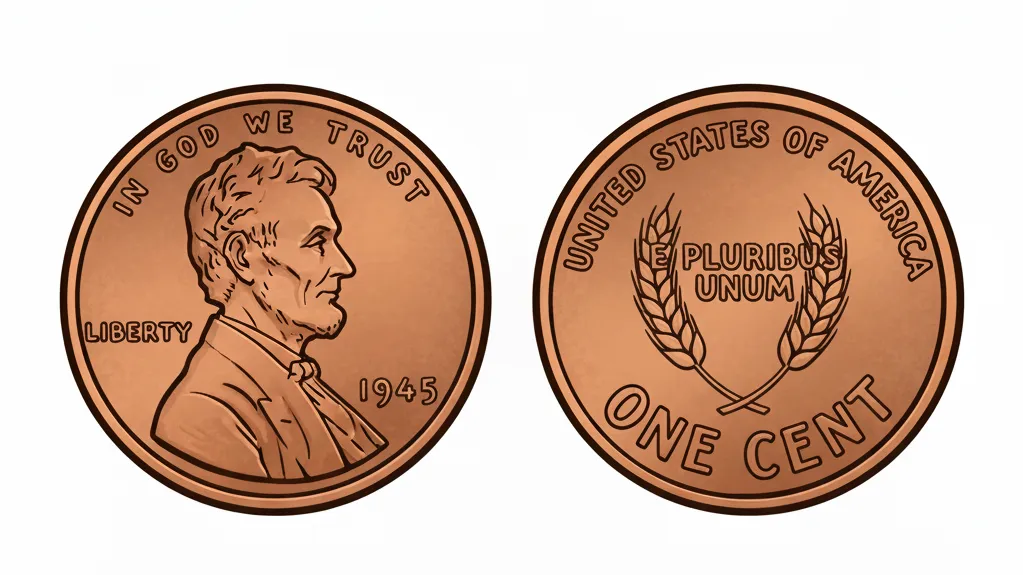
The 1945 Lincoln Wheat Penny: Wartime Legacy
You’ve probably noticed that among each series of tokens, there are certain release years that are valued the most.
But don’t worry, this value is not fixed, the top years can change from year to year and based on the needs of the public, those that were not particularly appreciated by collectors before, may become a target in a decade.
To be honest, the 1945 penny is not very popular among numismatists, but this does not mean that you should skip it and look only for tokens for millions of dollars.

Design and Main Features
The 1945 cent design was introduced in 1909 in honor of the 100th anniversary of Abraham Lincoln’s birth.
Obverse
Above Lincoln’s head is the inscription “IN GOD WE TRUST”
To the left of the portrait is the word “LIBERTY”
To the right is the year of minting — 1945, under which there may be a mint mark like “D” for Denver or “S” for San Francisco, or nothing indicating Philadelphia.
Reverse
In the center, in four lines, the denomination “ONE CENT” and the country “UNITED STATES OF AMERICA” are indicated.
The Latin motto “E PLURIBUS UNUM” is placed in the upper part of the reverse.
Specifications of the 1945 Coin
| Series | Lincoln Wheat Cent |
| Designer | Victor David Brenner |
| Diameter | 19.00 mm (19.05 mm) |
| Weight | 3.11 grams (48 grains) |
| Composition | 95% Copper, 5% Zinc/Tin |
| Edge | Plain |
Metal Transition
The Crisis of 1943
During World War II, copper was needed for the production of ammunition, cables, and military equipment.
So, in 1943, the US Mint was forced to take an unprecedented step: to mint one-cent coins from low-carbon steel coated with a thin layer of zinc, they have become the only exception of minting one-cent coins made of copper alloys.
The Return to Copper in 1944-1946
Starting in 1944, due to the improved supply situation, the Mint was able to return to copper alloy but the raw materials for the coinage were non-standard.
The alloy for the 1944, 1945 and 1946 coinage was indeed obtained, among other things, through the processing of various copper waste, including, according to some reports, used brass shell casings.
So, the composition of the 1945 coin as 95% copper, 5% zinc and/or tin was the result of recycling and using available wartime metal reserves, and although it wasn’t a pure, homogeneous alloy, as in the pre-war years, the coins successfully returned to a weight of 3.11 grams.
Minting and Production
| Mint | Mintage |
| Philadelphia (No mark) | 1 040 515 000 |
| Denver (D) | 266 268 000 |
| San Francisco (S) | 181 770 000 |
Numismatic Value, Preservation and Color Gradation
The true value of a 1945 cent is determined not by its circulation, but by its degree of preservation and color.
Preservation Scale and Color
- BN (Brown / Brown): The coin has completely oxidized, and the original red color of the copper has been lost.
- RB (Red-Brown / Red-brown): The original red color has been partially preserved from 25% to 75%
- RD (Red / Red): The coin has retained more than 75% of the original, bright red copper color
Pricing by Degree of Safety
- Good-XF: The cost ranges from nominal to $0.25 – $0.50.
- MS-60 – MS-64: The coin has not been in circulation, but it may have traces of contact or a faint color. and the price ranges from $1 to $15.
| Issue | MS-65 Red | MS-67 Red | Auction Record (MS-67+ / MS-68) |
| 1945 (P) | $20 – $50 | $200 – $400 | $20,400 (MS-67+ RD) |
| 1945-D | $30 – $70 | $150 – $350 | Up to $15,000 (MS-67 RD) |
| 1945-S | $40 – $80 | $300 – $600 | $6,600 (MS-68 RD) |
A difference of one degree or one color designation for example, between MS-66 RB and MS-67 RD) can mean a difference of hundreds or even thousands of dollars.
Rare Varieties and Errors
Double Die
This error occurs when the stamp receives two slightly offset prints of the image when it is created. I
Look for clear but small duplications of the outlines of letters or numbers.
Such coins, depending on the degree of doubling, can be estimated from $100 to $500.
Re-Minted Mint Mark (RPM)
Occurs when the Mint mark (“D” or “S”) has been punched on the working stamp several times with a slight offset.
1945-D RPM: Recorded varieties where traces of the previous, incorrectly positioned “D” sign can be seen under the date.
This one is in steady demand because they are relatively easy to identify, and can cost up to $100.

Some Other Errors
Clipped Planchet: An error in which part of a coin is “bitten off” by a semicircular segment due to incomplete or incorrect entry of the workpiece into the press, depending on the degree of pruning, such coins can cost from $25 to $300.
Broad Strike: Occurs when a coin is minted without a restrictive ring — the metal spreads out, and the coin has a larger diameter, and its edge is smooth and indistinct.
- Value: $50 – $200.
Lamination Errors: Defects related to the stratification of a low-quality wartime alloy. Peeling areas or swellings may be visible on the surface — up to $160.
Collecting and Historical Significance
From the point of view of collecting, the 1945 cent poses two main tasks for collectors:
It is necessary to collect three coins (P, D, S), preferably in the MS-65 Red state or higher.
Only those that have been able to preserve their original copper color and luster are valuable.
For those who want to purchase a copy of the highest quality, certification from PCGS or NGC is required. These companies guarantee not only the authenticity and degree of safety, but also the key color designation (RD) for copper coins, directly affecting the final price at auctions.
Conclusion
As with most coins, the price tag for the 1945 Wheat Penny can vary greatly, and the main mistake for a beginner is not to pay attention to a medium—quality token, but to look only for the perfect ones without a single scratch. Of course, among numismatists, the desire to create the perfect collection is appreciated, it is really prestigious, but it is too difficult and as a result, collectors have been stagnating for years, acquiring nothing and focusing only on MS-65 at least. Be wiser, set out to collect a collection not only for monetary gain, but for the soul — after all, you initially entered this business with burning eyes.